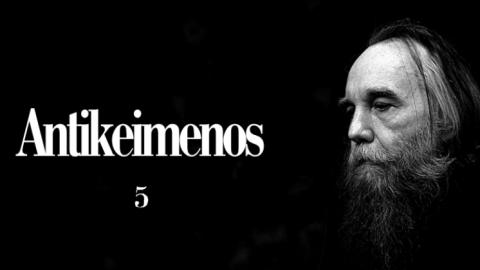ANTIKEIMENOS [5]
Primary tabs

In other religions and traditions, especially polytheistic ones, the metaphysics of war, of the final battle, is somewhat attenuated. In terms of form - morphology - it can be reduced to the invariable repetition of cyclical situations, they are prototyped by the annual cycle.
If we describe the morphology of the end of the world in this context, we obtain a classic cyclical-calendar model.
The dark times are winter/night/darkness/coldness/death. This is the entourage. 'The Antichrist of the calendar' is a personification of the period immediately preceding the midnight point in the diurnal cycle or the winter solstice point in the annual cycle.
Where does the parody come from? In the morphology of the calendar everything is clear: evening twilight is similar to morning twilight, autumn to spring, dawn to sunrise, morning star to evening star (Lucifer of the Romans).
Cyclical symbolism and the map/calendar are clearly at the basis of the linguistic set with which the traditions operate.
The object of the Christian Antichrist-like figures can be reduced to this calendar morphology.
In terms of connotative research, this gives us an exhaustive result, as it offers a sign map that can also be applied to more complex mythologies and theologies. In this sense, eschatology is - at least structurally - derivable from a marked cyclical symbolism.
But in denotative terms, we find ourselves in a situation where we have to admit that we are dealing with a hypostasis of natural phenomena elevated to the rank of a religious-mythological identity; that is, the denotation of the 'Antichrist of the calendar' is only one sector of the natural cycle and its corresponding symbolic topology (the sea, the underworld, the pits, the burrows, the roots, the bottom - from which Shamballa comes, etc.).
The adversary of the 'Antichrist of the calendar', therefore, is the next cycle, symmetrically located in relation to it on the other side of the winter solstice point. Two UR runes (two mountains, two horns, two gates, two-faced Janus, twins, etc.) illustrate all the possible scenario motifs clearly enough [58].
The sociology of the Antichrist
The introduction of calendarity and cyclicity allows us to give the 'Antichrist' (in a structurally generalised form) also a sociological interpretation. It is a state of society with an opposite purpose to the normative one. Such cyclical observations of society are already found in Ibn Khaldun, the father of sociology [59]. Society goes through cyclical phases, at the end of one cycle a new one follows. The end of the social cycle is the 'last time' of sociology.
Society is concrete; this concreteness of society is reflected in the structure of its temporality; sooner or later society degrades and disintegrates (not itself, but its concreteness). A period of anarchy and chaos follows, then a new society begins a new cycle. It is a new concreteness, Sorokin describes it through the following series: idealistic/idealistic/sensualistic society, and idealistic again [60].
In this sense, eschatology is a period that completes the concrete society. And the Antichrist as asociological phenomenon can be seen as a generalisation or personification of the final agony of this society.
According to Sorokin, the sensual model of the socio-cultural system is the final stage before the new idealisation. The culmination of the sensual system, according to Sorokin, is the 'sociological Antichrist' and the sensual system itself is the 'kali yuga' or apocalyptic society.
It is indicative that Christianity also links the moment of the Antichrist's arrival with sociopolitical changes (i.e. with the 'withdrawal of catechumens from the environment' - according to John Chrysostom).
Societies are different, so their social eschatologies are structurally similar, but temporally/historically different. What is flourishing for one society may look like a decline for another. It all depends on the structure of concreteness.
Only society itself knows what it really is and, consequently, only within it is it possible to conceive of its end, its eschatological phase.
[58] Дугин А. Г. Знаки Великого Норда. М.: Вече, 2008.
[59] Ibn Khaldūn The Muqaddimah; An Introduction to History. 3 volumes. New York; London: Princeton University Press, 1958.
[60] Сорокин П.А. Социальная и культурная динамика. М.: Астрель, 2006.
ANTIKEIMENOS [1]
ANTIKEIMENOS [2]
ANTIKEIMENOS [3]
ANTIKEIMENOS [4]
Translation by Lorenzo Maria Pacini
